PORT OF BORDEAUX'S NEW INTERCEPTOR 48 PILOT BOAT 'QUINOA'
Safehaven Marine have delivered
'QUINOA' an Interceptor 48, 14.5m Pilot Vessel to the Port of
Quinoa, our first Interceptor 48 / 14.5m pilot vessel has been delivered by sea to Bordeaux, here is an account of the voyage by Olivier Barreau, the pilot chiefly involved in overseeing her construction and who undertook the delivery voyage.
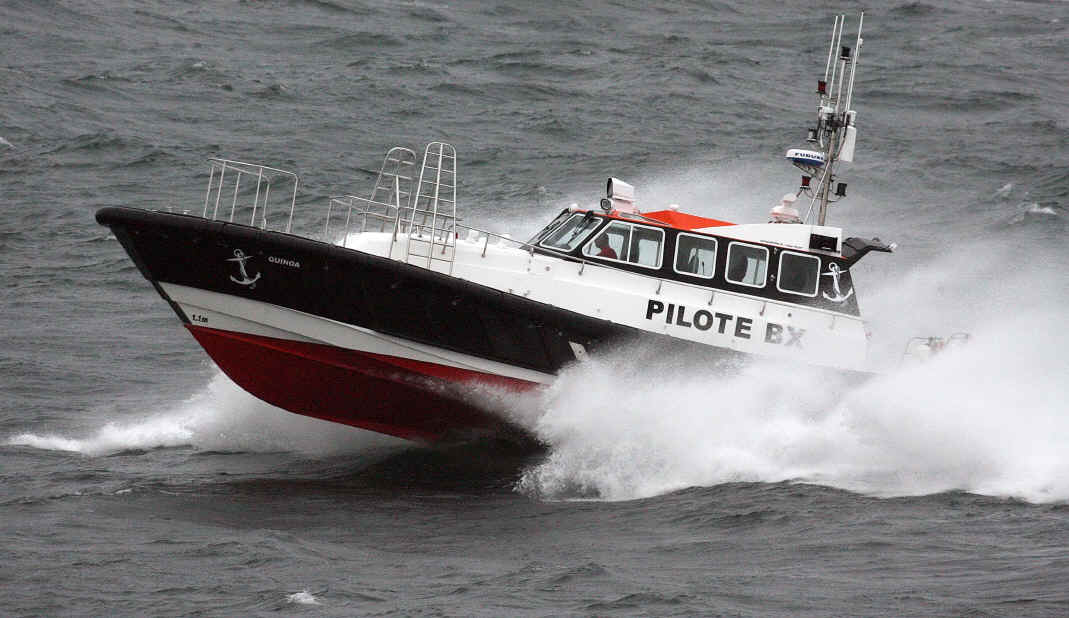
THE
VOYAGE OF 'QUINOA' FROM
Quinoa left Ireland at 11am on
Saturday, conditions were NW force 5 with a 2m swell offshore, conditions being
worst off Ireland where there was a cross sea of the main Westerly swell, and
wind waves at 90 degrees to this, but she handled conditions perfectly and was
able to average 22kts comfortably in a following sea. We made the140nm run to
Lands End in 6 hrs. After refueling at Newlyn and a short break, we cast off at
We continued down through
Biscay stopping off at Concarneau in
the morning where we refueled and drank a toast of
We departed quite late and
headed to
We continued on towards
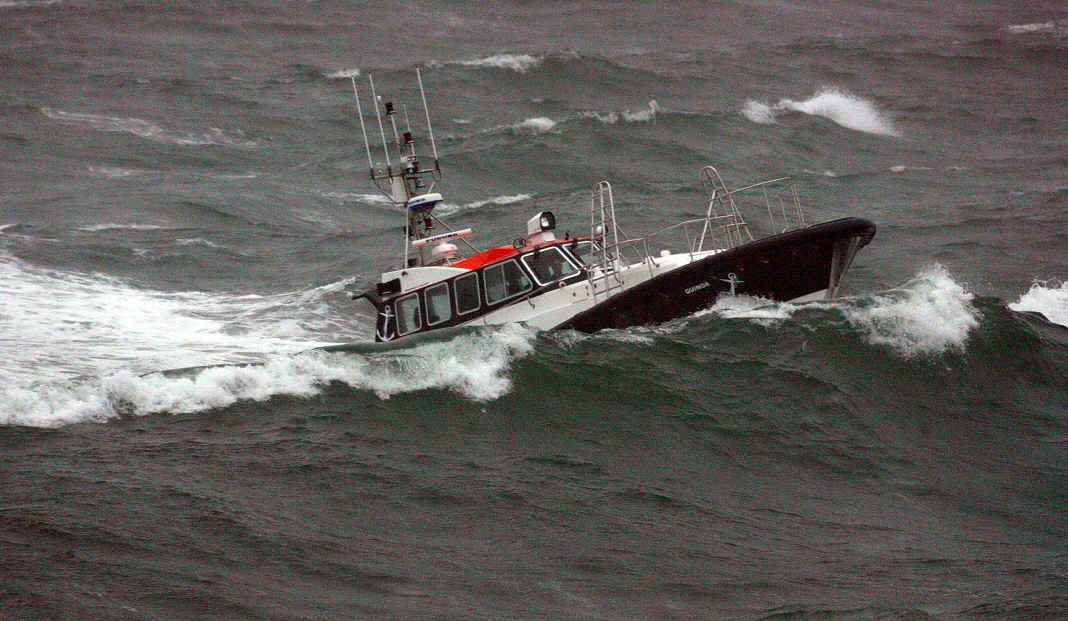
Above and below, some photos of Quinoa undergoing rough weather seekeeping trials during which she provd excellent with a soft ride running into head seas and being very stable running down wind with a following sea, you can see a video of the trials from this link- SEE THE VIDEO
The Interceptor 48 also features
fendering by Ocean 3, which is to the industry standard in
The Interior of Qunoa was especially designed from the outset to combine the highest level of 'yacht' standard fit out, with the most comfortable and efficient crew and pilot environments. To this end the cabin is fully lined in off white headlining and black gloss laminates and features a teak and holy cabin sole. The helm position comprises a wrap around GRP console incorporating all the navigation and engine instruments within easy view of the helmsman and providing an ergonomically comfortable car like driving position giving the helmsman the utmost comfort and control of the vessel. Pilots and crew likewise benefit from five reclining Recaro air suspension seats on black gloss GRP pedestals (although seating can be increased to 6 pilot seats if required)
The pilots at Bordeaux have to deal with very challenging and at times dangerous seas at the entrance to the Harbour where big Atlantic swells from the Bay of Biscay meet the strong 3-4kt ebb tide from the Gironde River and rage with special violence causing breaking seas at the Bar that reach over 10m in height during winter months, the Pilot vessel is expected to be able to navigate the Bar safely in up to 5m wave heights. As a consequence a fundamental requirement by the Port was for a pilot vessel with very high levels of sea keeping and Safehaven Marines reputation in this respect was unsurpassed by any other builder. An important part of the design brief was for the Interceptor 48 to be fully self righting in the event of capsize by virtue of her high buoyancy superstructure and consequently the vessel has been built with numerous features such as automatically closing air vents, 15mm thick windows and watertight cockpit doors. In addition the superstructures forward windows are aft sloping to minimise pressure loadings when taking green seas over the bow, (a fairly regular occurrence due to the extreme conditions she operates in) Another advantage of the Interceptor 48 is the inclusion of a large and spacious forward cabin, this is achieved by virtue of having her engines installed further aft under the main cabin, where they are subject to less loadings and accelerations in rough seas, and are quickly removed in the unlikely event of failure through hatches incorporated in the main cabin sole and cabin roof. The forward cabin on Quinoa features bunk berths allowing the pilots to rest and relax comfortably during transits at night time, and provides increased seating capacity that can be utilised in an emergency, or when additional passenger seating is required.. Quinoa is fitted with Safehaven's unique pilot boarding ladder design improving safety for pilots when boarding but causing minimum obstruction to visibility. Quinoa was built under Bureau Veritas survey to the strict French Maritime authority requirements.
The vessel was delivered at the
end of September by Olivier Barreau, the pilot specifically involved in
overseeing her design and construction whom became good friends with Safehaven's
owner and designer Frank Kowalski during the 12mths of her construction. The
500nm voyage from
The Interceptor 48 has proved to be a very fast and efficient hull design. Fitted with Iveco C13 engines at a continuous rating of 520hp Quinoa achieved a maximum speed with 1/4 fuel load of 26kts, and 25kts fully loaded with 1850 litres fuel and three crew at a displacement of 19,200kg.
|
RPM
Speed |
Speed One
way Kts |
Speed Opposite
Way (Kts) |
Average
speed (Kts) |
Running Trim range adjustable
with trim tabs |
Noise db |
|
|
1500 |
13.1 |
14 |
13.5 |
2.5
- 4.5 |
|
|
|
1600 |
15.1 |
16 |
15.5 |
2.6
- 4.8 |
|
|
|
1700 |
17 |
18.3 |
17.65 |
2.5
- 5 |
|
|
|
1800 |
19.3 |
20.5 |
19.9 |
2.5
- 5 |
73 |
|
|
1850 |
20.1 |
21.3 |
20.7 |
2.5
- 5.2 |
73 |
|
|
1900 |
21.6 |
23.3 |
22.5 |
2.5
- 5.2 |
74 |
|
|
1920 |
22.2 |
23.8 |
23 |
2.5
- 5.5 |
73 |
|
|
2040 |
25.3 |
26 |
25.65 |
2.5
- 5.3 |
73 |
Possibly the prettiest Pilot vessel we have built, the Interceptor 48 has sleek and graceful lines
Her interior is finished to a very high standard, fully lined throughout in vinyl with black gloss laminates, teak and holy cabin sole sandwiched with 40mm of soundproofing and wood trimming produce an exceptionally luxurious environment for her pilots and crew. Four reclining Recardo air suspension pilot seats with side bolsters will give a comfortable ride in rough weather.
The helm position has been especially designed to provide the ultimate comfort and control for the helmsman, the design wraps around with all instrumentation clearly visible and all the vessel controls have been ergonomically designed for comfort and visibility. 'Quinoa' is fitted with a sophisticated navigation package centered around the Furuno Nav Net 3D electronic system with twin radar scanners.
Twin Iveco C13 520hp engines and Twin Disc 5114 Quick Shift gearboxes. Engineering and electrical installations are the the highest international standards.
Pilot boarding ladders at the bow provide safe boarding of ships, especially in heavy seas, reducing the risk to pilots.
The Interceptor 48 is based closely on our very successful and renowned Interceptor 42 hull. Changes to the original 42 design have been kept to subtle improvements that will retain the Interceptor 42's excellent sea keeping, but incorporate some refinements. Rake of her stem is reduced by two degrees, visually unnoticeable but keeping LOA down. Her moulded length is 14.2m as opposed to the 42's 12.9m , and her L.O.A. will be 14.7m. Her main chine rises 150mm higher which will soften her ride and keep spray suppression constant at lower trim levels achievable with trim tabs in head seas. Her beam at deck edge has been increased from 4.2m to 4.4m at the shoulders and reduced slightly at the transom. Her height and depth is identical to the 42 which will retain a similar VCG (most important) and result in a sleeker design. Overall deadrise and hull form design are the same, but a slightly sharper forefoot (55 degrees as opposed to the 42's 52 degrees) will soften her ride in short choppy seas,. One design feature will be the incorporation of integral trim plates built into underneath of the hull at the transom. This will allow the fitting of large trim tabs that will not protrude significantly past the transom thereby providing protection for them, but will allow drastic running trim adjustments for head sea work by depressing the bow. Overall her increased length is aft at the transom, which will increase buoyancy at the stern and lower running trim. Similar speed and powering requirements to the 42 are expected.
Her bow is rounded, which allows the main fender to be wrapped around in a continuous run. The gunwale flat area is 300mm as opposed to 150mm, obviously this will allow incorporation of larger different fender solutions, but where traditional delta section is chosen, which will still be an option, it will allow for a double run at the stem and transom quarters, protecting the hull further. Also the rounded bow is ascetically very pleasing. She has a slightly increased stern overhang to allow increased protection of the rudders under the hull. Her transom quarters have been rounded off to a much greater extent allowing a continuous run to wrap around and the curve strengthens the area. A slight curve is incorporated for ascetic reasons and adds to her graceful design. This compliments the 42's 'seagull wing' sheer line which is retained, differing only at the bow, which has been raised to run straight without the reverse sheer (as on the 55) this will improve the likelihood of shipping green seas further.
The 48 hull will retain all the 42's excellent seakeeping characteristics and graceful design, but offer slight improvements everywhere.
Below, her GRP fuel tank puts her full fuel load of 2,000l below the waterline, enhancing stability.
From the outset, an important part of the design criteria for the Bordeaux Interceptor 48 pilot, was that the vessel to be inherently self righting. This would be achieved as a result of the superstructure designs size and buoyancy, preventing the vessel from staying in an inverted position after capsize by a breaking sea. The superstructure is of a size large enough, with enough internal volume to automatically right the vessel.
Obviously there are a number of other factors affecting the self righting capabilities of a vessel, and the Interceptor 48 pilot boat incorporates a number of additional design features to achieve self righting. These are:
Window design. The windows of the Interceptor Pilot have been deliberately kept as small as practical without affecting visibility in order to reduce the likelihood of a window been shattered by the force of water a stronger thicker design specification of 15mm glass is used throughout
In addition the two front side windows are not of an opening design.
Aft cabin door. The aft cabin door on the Interceptor Pilot is designed to be fully watertight.
Engine room Air Intakes. The design of the engine room air intakes incorporate anti flooding features to prevent flooding of the engine room in the event of a capsize. The design features a weight and float system on the air intakes that would shut the intake when the vessel was inverted.
Inclinometer switch incorporated to the engine management system that would automatically shut the engines off if the vessels angle of heel exceeds 90 degrees.
Cabin ventilation. All cabin ventilators are of a design that facilitate automatic closure in the event of operating in dangerous conditions. In addition the main cabin ventilation system is of a design similar to the engine room anti flooding design to prevent water entering the main accommodation area in the event of capsize.
Throughout the vessel special attention and modifications are incorporated to ensure that all fixtures and fittings are strong enough to survive and remain operational in a prolonged, inverted 180 degree position.
Below:
The floatation line of the
Interceptor 48 Pilot in its inverted position is shown below. As can be seen,
the size and buoyancy of the cabin prevents the vessel from being stable
inverted.
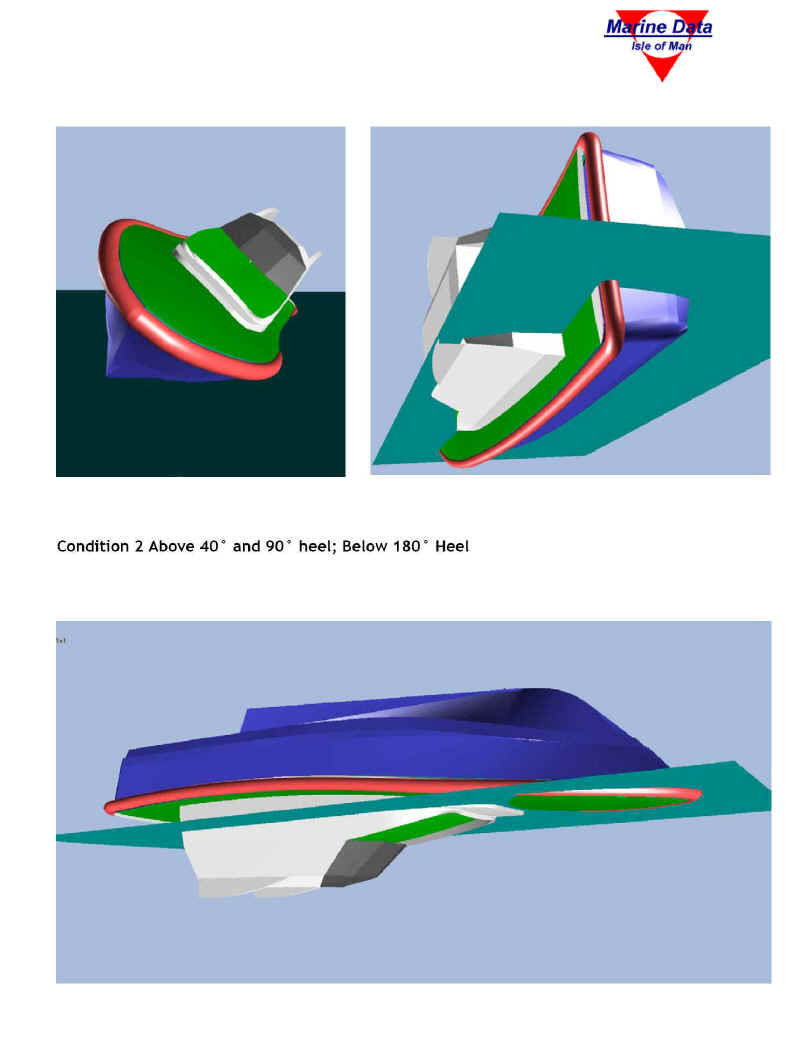
Below-
The large heel angle stability graph shows that at no pint in 180 degrees of
heel does the stability become negative.
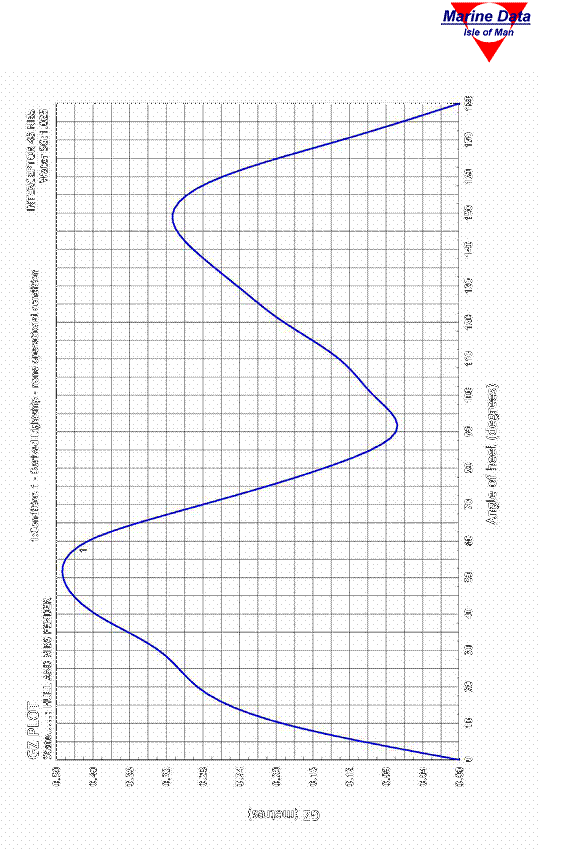
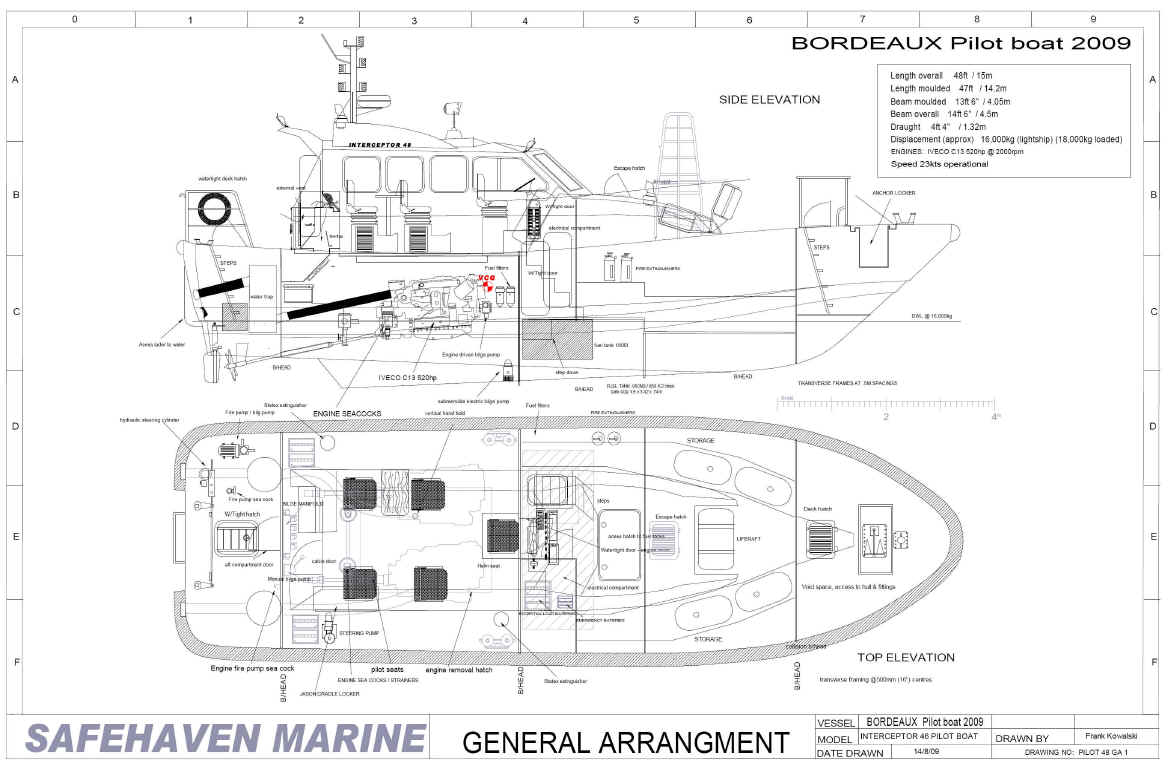
The first Interceptor 48 hull is lifted from the mould. below.